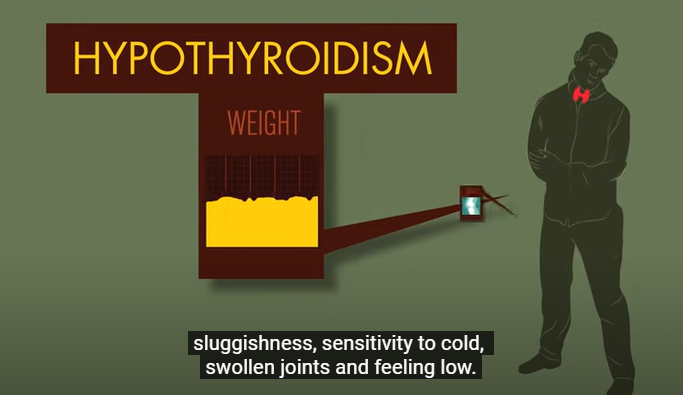5 Ways to Prevent Food Poisoning – Prevention And Knowledge Matters
Food poisoning, also known as foodborne illness, occurs when an individual consumes contaminated food or beverages. Understanding Food Poisoning is key. There are 5 ways to prevent food poisoning. Various pathogens, including bacteria, viruses, parasites, or toxins, cause this contamination. Common culprits include Salmonella, E. coli, Listeria, and Norovirus. 
5 Ways to Prevent Food Poisoning
The impact of food poisoning on health ranges from mild discomfort to severe, life-threatening conditions. Typical symptoms include nausea, vomiting, diarrhea, abdominal pain, and fever. These symptoms usually appear within hours to days after consuming contaminated food and may last from a few hours to several days. By learning the 5 ways to prevent food poisoning, you’ll learn how to navigate through it with less stress.
In more severe cases, food poisoning leads to dehydration, electrolyte imbalances, and even organ damage. Certain populations, such as young children, elderly individuals, pregnant women, and those with weakened immune systems, are at higher risk for severe complications. In rare cases, foodborne illnesses results in long-term health issues or even death.
Statistics About the Prevalence of Food Poisoning
Food poisoning is a significant global health concern. According to the World Health Organization (WHO), an estimated 600 million people worldwide fall ill after eating contaminated food each year, and 420,000 die as a result.
In the United States, the Centers for Disease Control and Prevention (CDC) estimates that 48 million people get sick from foodborne diseases annually. This translates to 1 in 6 Americans experiencing food poisoning each year. Of these cases, approximately 128,000 are hospitalized, and 3,000 die. 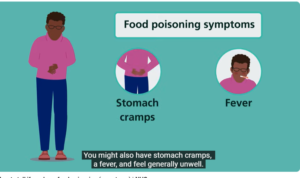
Certain pathogens are responsible for the majority of foodborne illnesses. For instance, Norovirus causes about 58% of foodborne illnesses in the U.S., while Salmonella is the leading cause of hospitalizations and deaths related to food poisoning.
It’s important to note that these statistics likely underestimate the true prevalence of food poisoning, as many cases go unreported or are misdiagnosed.
My Bout With Noravirus
I’ll never forget the time I spent the night in the ER. By the time I arrived I was totally faint and dehydrated. As a result, I had to be hooked up to an IV drip to replenish all the liquids lost while enduring severe symptoms of the Nora virus. However, a few months prior I recall my mother-in-law had the exact same symptoms about 3 months prior.
While I was at the pharmacy to pick up a prescription, I remember feeling faint and light-headed. Seemed like weakness came over me as I was leaving the store. By the time I got home, I first felt nauseous and then all of a sudden I had a surge of projectile vomiting. My husband proceeded to take me to the nearby San Gorgonia hospital. 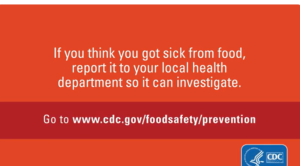
I stayed overnight while all the fluids in my system was replaced. To this day, I have no idea where I contracted the Noravirus (other than my M-in-L). It was the first time in my life that I had experienced anything of this caliber. Since that time, I have not had any such virus. However, I am just recovering from food poisoing and it, too, is no joke.
Long story short, I’m just recovering from a food-borne disease. My physician says that I probably had too much fiber or maybe ingested chemical toxins from food ingredients such as MSG. Whatever it was, it caused me some major gastronomical issues, bloating and intestinal discomfort. This was a flashback of when I have food poisoning as a child. Back then, the stomach pain was unbearable. Food poisoning is no joke.
The Role of Individuals in Preventing Food Poisoning
While food safety is a shared responsibility among governments, food producers, and consumers, individuals play a crucial role in preventing food poisoning.
Here are some keyways individuals contribute to food safety:
1) Practice proper hand hygiene: Wash hands thoroughly with soap and water before handling food, after using the bathroom, and after touching raw meat or eggs.
2) Cook foods to safe internal temperatures: Use a food thermometer to ensure meats, poultry, and eggs are cooked to recommended temperatures to kill harmful bacteria.
3) Avoid cross-contamination: Use separate cutting boards and utensils for raw meats and ready-to-eat foods. Clean surfaces and utensils thoroughly after contact with raw foods.
4) Store foods properly: Refrigerate perishable foods promptly and maintain proper refrigerator and freezer temperatures.
5) Be aware of high-risk foods: Exercise caution with foods that are more likely to cause food poisoning, such as raw or undercooked meats, unpasteurized dairy products, and unwashed fruits and vegetables. 
6) Stay informed about food recalls: Pay attention to food safety alerts and recalls issued by regulatory authorities.
7) Practice safe food handling when eating out: Choose restaurants that maintain good hygiene practices and report any concerns about food safety to local health authorities such as the CDC. This is a part of living a healthy lifestyle.
By understanding the risks associated with food poisoning and taking proactive steps to prevent it, individuals will significantly reduce their risk of foodborne illness and contribute to overall public health. 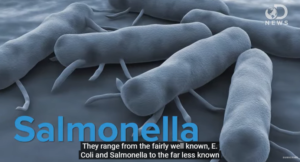
Maintain Cleanliness
The First Defense Against Food Poisoning
Emphasize the importance of handwashing and surface sanitation
Proper handwashing and surface sanitation are crucial steps in preventing food poisoning. Hands harbor numerous bacteria and viruses, which will easily be transferred to food during preparation.
To effectively wash your hands:
- Use warm water and soap
- Scrub for at least 20 seconds, paying attention to areas between fingers and under nails
- Rinse thoroughly and dry with a clean towel
Wash hands before and after handling food, especially raw meats, and after using the bathroom, touching pets, or handling garbage.
Surface sanitation is equally important. Clean and sanitize all food preparation surfaces before and after use. Use hot, soapy water to clean, followed by a sanitizing solution (1 tablespoon of unscented chlorine bleach per gallon of water). 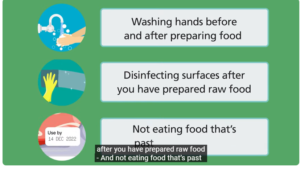
Pay special attention to cutting boards, countertops, and areas that frequently come into contact with food.
The Role of Clean Cooking Utensils and Dishware
Clean cooking utensils and dishware play a vital role in preventing cross-contamination and the spread of harmful bacteria.
To ensure cleanliness:
- Wash all utensils, cutting boards, and dishes with hot, soapy water after each use
- Consider using separate cutting boards for raw meats and vegetables
- Regularly sanitize utensils and dishware in a dishwasher or with a sanitizing solution
- Replace sponges and dishcloths frequently, as they can harbor bacteria
- Store clean utensils and dishware in a clean, dry place
- Pay special attention to items that come into direct contact with food, such as can openers, meat thermometers, and blender blades.
Tips on Maintaining a Hygienic Kitchen Environment
A clean kitchen environment is essential for food safety.
Here are some tips to maintain hygiene:
- Regularly clean and disinfect high-touch areas like refrigerator handles, faucets, and light switches
- Keep garbage containers covered and empty them frequently
- Clean spills immediately to prevent bacterial growth
- Properly store cleaning supplies away from food items
- Maintain good ventilation to reduce moisture and prevent mold growth
- Regularly clean the inside of your refrigerator and freezer
- Wash kitchen towels and dishcloths frequently using hot water
- Keep pets out of food preparation areas
- Regularly inspect for and address any signs of pest infestation
By following these guidelines, you’ll significantly reduce the risk of food poisoning and maintain a safe, hygienic kitchen environment. 
Smart Selection and Proper Storage of Food
Emphasize the Importance of Handwashing and Surface Sanitation
Proper handwashing and surface sanitation are critical components of food safety. Hands can easily transfer harmful bacteria and viruses to food, utensils, and surfaces, potentially leading to foodborne illnesses.
To prevent this:
- Wash hands thoroughly with soap and warm water for at least 20 seconds before handling food, after touching raw meat, after using the bathroom, and after handling pets or garbage.
- Use paper towels or clean clothes to dry hands, as dirty towels can decontaminate clean hands.
- Regularly sanitize kitchen surfaces, especially those that come into contact with raw meats or produce. Use a diluted bleach solution or commercial sanitizer.
- Pay special attention to high-touch areas like refrigerator handles, faucets, and countertops.
- Clean up spills immediately to prevent bacterial growth.
Discuss the Role of Clean Cooking Utensils and Dishware
- Clean cooking utensils and dishware play a crucial role in maintaining food safety:
- Wash all utensils, cutting boards, and dishes with hot, soapy water after each use.
- Consider using separate cutting boards for raw meats and produce to prevent cross-contamination.
- Sanitize cutting boards periodically, especially after cutting raw meat.
- Inspect dishes and utensils for cracks or chips where bacteria can hide.
- Allow dishes and utensils to air dry when possible, as dish towels can harbor bacteria.
- Regularly clean and sanitize dish scrubbers and sponges or replace them frequently.
- Use the sanitize cycle on your dishwasher when available for an extra level of cleanliness.
Tips on Maintaining a Hygienic Kitchen Environment
Maintaining a hygienic kitchen environment goes beyond just cleaning. 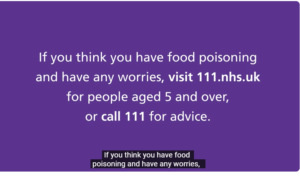
Consider these tips:
- Organize your refrigerator to prevent cross-contamination. Store raw meats on the bottom shelf to prevent drips onto other foods.
- Regularly clean and defrost your refrigerator and freezer.
- Keep your garbage area clean and take out the trash regularly to prevent odors and pest attraction.
- Use sealed containers for food storage to prevent contamination and pest infestation.
- Regularly wash and replace kitchen towels and dishcloths.
- Keep pets out of food preparation areas.
- Ensure proper ventilation to reduce moisture and prevent mold growth.
- Regularly clean your sink and disposal, as these areas can harbor bacteria.
- Check for and seal any entry points for pests.
- Maintain a regular cleaning schedule for less frequently used areas like the inside of the microwave or toaster oven.
By following these guidelines, you significantly reduce the risk of foodborne illnesses and maintain a clean, safe kitchen environment.
Be Safe When You Buy Online
As an avid online shopper, I admit that all canned or packaged foods is not exempt from unsafe foods. An few years ago I returned a packaged meal to Amazon. When I opend the product, it had a foul smell. I was supposedly a fancy dish. However, I still see the product on their website. Hopefully, it will be recalled.
Discard Expired Goods
Luckily, I did not consume a contaminated products a few years ago. However, not everyone is this lucky. My good friend Augie will never use another canned product. His little niece lost her eye when she was attempting to open a can of food. It, literally exploded in her eye. Another key essential is to always read the expiration date and discard expired goods. 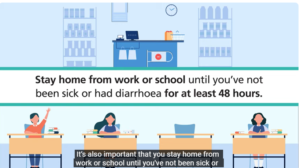
The Cruciality of Cooking Food to the Right Temperature
Cooking food to the proper internal temperature is essential for food safety. Different types of food require different minimum temperatures to ensure harmful bacteria are killed.
For example:
- Poultry (whole or ground): 165°F (74°C)
- Ground meats (beef, pork, lamb): 160°F (71°C)
- Fresh beef, pork, lamb (steaks, roasts, chops): 145°F (63°C) with a 3-minute rest time
- Fish and shellfish: 145°F (63°C)
Using a food thermometer is the only reliable way to ensure foods have reached a safe internal temperature. Color and texture are not reliable indicators. Undercooking can leave harmful pathogens alive in the food, potentially causing foodborne illnesses.
Guidance on Avoiding Cross-Contamination
Cross-contamination occurs when bacteria or other microorganisms are unintentionally transferred from one object to another, often leading to the spread of foodborne pathogens.
To avoid this:
1. Use separate cutting boards for raw meats and produce.
2. Wash hands thoroughly before and after handling raw foods.
3. Clean and sanitize kitchen surfaces, utensils, and equipment after contact with raw meats.
4. Store raw meats on the bottom shelf of the refrigerator to prevent juices from dripping onto other foods.
5. Never place cooked food on a plate that previously held raw meat without washing it first.
Handling Leftovers Safely to Minimize Risk
Proper handling of leftovers is crucial to prevent bacterial growth and potential food poisoning:
1. Refrigerate leftovers within 2 hours of cooking (1 hour if the temperature is above 90°F/32°C).
2. Cool food quickly by dividing large amounts into shallow containers.
3. Store leftovers in airtight containers or wrap tightly with plastic wrap or aluminum foil.
4. Use refrigerated leftovers within 3-4 days.
5. Reheat leftovers to an internal temperature of 165°F (74°C).
6. When in doubt, throw it out – if you’re unsure about the safety of leftovers, it’s better to discard them.
Selecting Reputable Restaurants with Good Hygiene Standards
Savvy Dining Out
When choosing a restaurant, prioritize establishments with a strong reputation for cleanliness and food safety. Look for restaurants that prominently display their health inspection scores or certificates. Many jurisdictions now require this information to be visible to customers.
Research online reviews, focusing on comments about cleanliness and food quality. While individual reviews can be subjective, patterns of hygiene-related complaints should be a red flag. Local health department websites often provide searchable databases of restaurant inspection reports, which can offer valuable insights into a restaurant’s hygiene practices.
Consider the overall cleanliness of the visible areas of the restaurant. A tidy dining room and clean restrooms often indicate good overall hygiene practices. Busy restaurants with high turnover rates for ingredients are generally a safer bet, as food is less likely to sit around for extended periods.
Awareness of Food Preparation and Handling
Pay attention to how staff handle food and maintain cleanliness. Servers and food handlers should wear clean uniforms, have neat and tidy hair, and avoid touching food directly with their hands. Look for the use of gloves, tongs, or other utensils when handling ready-to-eat foods.
Be cautious with high-risk foods like raw or undercooked meats, eggs, and seafood. These items are more likely to harbor harmful bacteria if not prepared correctly. When ordering such dishes, ensure they’re cooked to appropriate temperatures. For instance, ground beef should be cooked to at least 160°F (71°C) to kill potential pathogens.
Observe how hot foods are kept hot and cold foods are kept cold. Buffets and salad bars can be breeding grounds for bacteria if not maintained at proper temperatures. Foods should not be left at room temperature for extended periods.
How to Spot Warning Signs of Poor Food Safety Practices
Be alert for signs that might indicate subpar food safety practices:
1. Unclean tableware, utensils, or menus
2. Food service staff with unclean hands or improper handwashing practices
3. Cross-contamination, such as using the same cutting board or utensils for raw meats and ready-to-eat foods
4. Flies or other insects in food preparation or dining areas
5. Lukewarm food that should be served hot, or inadequately chilled items that should be cold
6. Strong, unpleasant odors that could indicate spoilage
7. Visible mold or discoloration on food items
8. Raw meat stored above other foods in open refrigeration units
If you notice any of these warning signs, consider dining elsewhere. Remember, it’s always better to err on the side of caution when it comes to food safety. Trust your instincts – if something doesn’t seem right, it probably isn’t.
By being observant and making informed choices, you can significantly reduce your risk of foodborne illness when dining out.
When choosing a restaurant, prioritize establishments with a strong reputation for cleanliness and food safety. Look for restaurants that prominently display their health inspection scores or certificates. Many jurisdictions now require this information to be visible to customers.
Research online reviews, focusing on comments about cleanliness and food quality. While individual reviews can be subjective, patterns of hygiene-related complaints should be a red flag. Local health department websites often provide searchable databases of restaurant inspection reports, which can offer valuable insights into a restaurant’s hygiene practices.
Consider the overall cleanliness of the visible areas of the restaurant. A tidy dining room and clean restrooms often indicate good overall hygiene practices. Busy restaurants with high turnover rates for ingredients are generally a safer bet, as food is less likely to sit around for extended periods.
Awareness of Food Preparation and Handling When Dining Out
Pay attention to how staff handle food and maintain cleanliness. Servers and food handlers should wear clean uniforms, have neat and tidy hair, and avoid touching food directly with their hands. Look for the use of gloves, tongs, or other utensils when handling ready-to-eat foods.
Be cautious with high-risk foods like raw or undercooked meats, eggs, and seafood. These items are more likely to harbor harmful bacteria if not prepared correctly. When ordering such dishes, ensure they’re cooked to appropriate temperatures. For instance, ground beef should be cooked to at least 160°F (71°C) to kill potential pathogens.
Observe how hot foods are kept hot and cold foods are kept cold. Buffets and salad bars can be breeding grounds for bacteria if not maintained at proper temperatures. Foods should not be left at room temperature for extended periods.
How to Spot Warning Signs of Poor Food Safety Practices
Be alert for signs that might indicate subpar food safety practices:
1. Unclean tableware, utensils, or menus
2. Food service staff with unclean hands or improper handwashing practices
3. Cross-contamination, such as using the same cutting board or utensils for raw meats and ready-to-eat foods
4. Flies or other insects in food preparation or dining areas
5. Lukewarm food that should be served hot, or inadequately chilled items that should be cold
6. Strong, unpleasant odors that could indicate spoilage
7. Visible mold or discoloration on food items
8. Raw meat stored above other foods in open refrigeration units
If you notice any of these warning signs, consider dining elsewhere. Remember, it’s always better to err on the side of caution when it comes to food safety. Trust your instincts – if something doesn’t seem right, it probably isn’t.
By being observant and making informed choices, you can significantly reduce your risk of foodborne illness when dining out.
Final Thoughts
Food poisoning prevention revolves around several critical practices. First and foremost is proper hand hygiene – always wash your hands thoroughly with soap and water before handling food, after touching raw meat, and after using the bathroom. Secondly, maintain appropriate food temperatures: keep cold foods cold (below 40°F/4°C) and hot foods hot (above 140°F/60°C) to inhibit bacterial growth.
Cook foods to their recommended internal temperatures, especially meats and eggs. Clean all surfaces, utensils, and cutting boards that come into contact with raw foods to prevent cross-contamination. Lastly, be mindful of food storage times and always check expiration dates before consumption.
Stay Informed
Staying informed about food safety is an ongoing process. As new research emerges and food production methods evolve, so too do best practices for preventing foodborne illnesses. Make it a habit to periodically refresh your knowledge on food safety guidelines.
Stay curious and open to learning new information – for instance, about emerging pathogens or updated recommendations for food handling. Remember that being proactive about food safety not only protects you but also your loved ones.
Consider it a form of self-care and responsibility towards your community. By maintaining awareness and continuously educating yourself, you become an advocate for food safety in your household and beyond.
Resources for Information on Food Poisoning Prevention
There are numerous reliable sources available for those seeking to deepen their understanding of food safety. Government health organizations like the CDC (Centers for Disease Control and Prevention) and FDA (Food and Drug Administration) offer comprehensive guides and up-to-date information on their websites.
Many universities with food science programs provide public education resources. For hands-on learning, consider taking a food safety certification course, such as ServSafe, which is widely recognized in the food service industry.
Mobile apps like FoodKeeper helps you track food freshness and storage times. Local health departments often offer community workshops on food safety. Lastly, reputable cookbooks and cooking shows frequently include food safety tips alongside recipes, making learning practical and enjoyable.
Founder and CEO
(w) mybluegenes.com
As an Amazon affiliate, I earn from qualifying purchases at NO extra cost to you.






